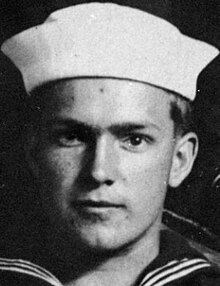Edward F. Sands
Edward F. Sands | |
|---|---|
 | |
| Born | Edward Fitzgerald Snyder April 4, 1894 Marion, Ohio, U.S. |
| Disappeared | February 2, 1922 (aged 27) |
| Nationality | American |
| Other names | Edward Fitzwilliam Strathmore, Jazz |
Edward F. Sands (born Edward Fitzgerald Snyder; April 4, 1894 – unknown), also known as Edward Fitzwilliam Strathmore and Jazz, was a suspect in the murder of Hollywood director William Desmond Taylor on February 1, 1922.[1][2]
Biography
[edit]Edward Sands had been employed as Taylor's personal assistant, serving as cook and valet. Although he was born in Ohio, he spoke with an affected English accent (screen star Mary Miles Minter referred to him as a cockney). Taylor left Sands in charge of his affairs during a vacation in 1921 and returned to find Sands gone and several of the director's possessions missing including his car, checkbook, a large supply of distinctive cigarettes and jewelry. Sands had cashed several blank checks left by Taylor and, using the stolen checkbook, began forging Taylor's signature.
A few months later Taylor received a letter from Sands which included a pawn ticket in the name of William Deane Tanner (Taylor's birth name), indicating that Sands knew Taylor's true identity, which Taylor had kept secret since his arrival in Hollywood eight years earlier. Sands seems to have returned clandestinely. One of the distinctive stolen cigarettes was found (smoked and crushed) on Taylor's doorstep and footprints were left on Taylor's bed. Some more of Taylor's jewelry was stolen and receipts were found showing Sands had sold the items in northern California.[3]
Military service
[edit]Sands had seven enlistments in the military under various names.
- He initially enlisted in the United States Navy at the Recruiting Station in Cincinnati, Ohio at the age of 17.[3] He served on the U.S.S. Franklin, U.S.S. Constellation, U.S.S. Montana, and U.S.S. Paducah with the assignments of pay office and canteen yeoman.[3] After serving on the U.S.S. Southery at the Navy Yard in Portsmouth, New Hampshire, he was discharged as a landsman on August 6, 1916.[3]
- On August 21, 1916, he joined the United States Coast Guard, where he served on the cutter Gresham and was discharged on August 20, 1917, as a cabin steward.[3]
- On October 17, 1917, he enlisted in the U.S. Naval Reserve at the Navy Yard in New York, New York.[3] On December 1, 1918, he was promoted to Chief Commissary Steward.[3]
- On February 8, 1919, he enlisted in the U.S. Navy at Kansas City, Missouri.[3]
- On April 17, 1919, he enlisted in the U.S. Coast Guard as a cook at Brooklyn, New York.[3]
- On May 22, 1919, he enlisted in the U.S. Army at Columbus Barracks, Ohio and was assigned to the finance office.[3] On August 25 he was promoted to sergeant.[3]
- On November 17, 1921, he enlisted in the U.S. Coast Guard and was assigned to the cutter Bear as a Mess Attendant 1st Class.[3]
Disappearance
[edit]An eyewitness reported seeing someone leaving Taylor's bungalow around the time he was murdered, but her description does not fully match Sands' appearance.[3] The police considered Sands a strong suspect, but never issued a warrant for his arrest in connection with the murder. Sands reportedly quit a job in northern California and disappeared the day of the murder. Subsequent investigations turned up evidence he had likely been arrested previously for petty crimes and had apparently deserted from the United States Coast Guard.[4] Sands was never found.
See also
[edit]References
[edit]- ^ "Badly Wanted". Time. August 26, 1929. Archived from the original on February 25, 2010. Retrieved 2007-07-21.
Edward F. Sands, 34, 5 ft 5 in., for the murder of William Desmond Taylor, cinema director, whose butler he was. Questioned in this case were Cinemactresses Mabel Normand, last to see Taylor alive, and Mary Miles Minter whose lingerie and love letters were found in the Taylor apartment.
- ^ "Letter From 'Sands' Offers To Clear Up The Taylor Murder; Writer, Asserting He Is Man Sought, Asks Dismissal of the Other Charges. Says He Knows Slayer District Attorney, Replying Through the Press, Agrees to All His Conditions. Slain Man Wore Locket It Was Gift From Mabel Normand, It Is Said, and Was Inscribed "To My Dearest."". The New York Times. 1922-02-18. ISSN 0362-4331. Retrieved 2020-01-07.
- ^ a b c d e f g h i j k l m Taylorology Archived 2006-10-20 at the Wayback Machine
- ^ Giroux, pp. 116–17.
Further reading
[edit]- Giroux, Robert, A Deed of Death: The Story Behind the Unsolved Murder of Hollywood Director William Desmond Taylor. Alfred A. Knopf, New York, 1990. ISBN 0-394-58075-3
